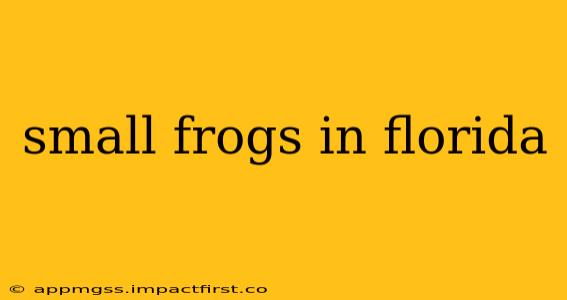Florida's diverse ecosystem boasts a remarkable variety of frog species, many of which are surprisingly small. Identifying these miniature amphibians can be challenging, but understanding their characteristics and habitats can greatly enhance your appreciation for Florida's natural world. This guide explores some of the smaller frog species found in the Sunshine State, addressing common questions along the way.
What are some of the smallest frog species in Florida?
Several frog species in Florida are relatively small, with sizes varying depending on age and sex. Some of the smaller ones include the Pine Woods Treefrog ( Hyla femoralis), the Squirrel Treefrog (Hyla squirella), and various species of narrow-mouthed toads (family Microhylidae). While exact measurements vary, these species generally fall within a smaller size range compared to larger Florida frogs like the Bullfrog. It's important to note that juvenile frogs of even larger species will naturally be much smaller.
Where can I find small frogs in Florida?
The location where you're most likely to find small frogs depends heavily on the specific species. For example:
-
Pine Woods Treefrogs: These tiny frogs prefer pine flatwoods and scrub habitats, often found near water sources. Look for them on vegetation at night, as they are nocturnal.
-
Squirrel Treefrogs: These equally petite frogs inhabit a broader range of environments including hardwood hammocks, cypress swamps, and even urban areas with suitable vegetation. They are also primarily nocturnal.
-
Narrow-mouthed Toads: This family encompasses several small species, with varying habitat preferences. Some prefer moist, sandy areas, others might be found near ponds or marshes.
What do small Florida frogs eat?
The diet of small Florida frogs varies depending on the species, but generally consists of small insects and invertebrates. Their diet may include:
- Ants: A staple food source for many small frogs.
- Termites: Another common prey item.
- Small spiders: Depending on size and species.
- Flies: Easily captured and a significant portion of the diet for many.
- Mosquitoes: Especially beneficial for mosquito control!
Their small size dictates the size of their prey – they are primarily insectivores, targeting small, easily manageable insects.
How can I tell the difference between a frog and a toad?
While the distinction isn't always clear-cut, toads generally have drier, bumpy skin, while frogs typically have smoother, moist skin. Toads also tend to have shorter legs and a stockier build than frogs. However, this is a generalization, and some species blur the lines. Careful observation and identification guides are needed for accurate species determination.
Are small frogs in Florida poisonous?
Most small frogs in Florida are not poisonous to humans. However, handling any amphibian should be done cautiously and with clean hands. Their skin can be sensitive, and while they don't typically pose a significant threat, it's always best to admire them from a respectful distance to avoid stressing the animal.
What is the best time of year to see small frogs in Florida?
The best time to spot small frogs in Florida is during the warmer months, from spring through autumn. Breeding season, which varies by species, often results in increased activity and easier sightings near water sources. Rainfall can also influence their activity levels, with heavier rainfall often bringing them out.
What threats do small frogs face in Florida?
Like many amphibian populations worldwide, small Florida frogs face several threats:
- Habitat loss: Development and urbanization significantly reduce their natural habitats.
- Pollution: Chemical runoff and pollutants in water sources can harm frog populations.
- Invasive species: Competition from introduced species can impact their survival.
- Climate change: Changing weather patterns and increased temperatures can disrupt their life cycles.
By understanding the characteristics, habitats, and challenges faced by small frogs in Florida, we can better appreciate their ecological importance and contribute to their conservation. Responsible observation and support for habitat preservation are crucial to ensuring the continued presence of these fascinating creatures in the Sunshine State.
